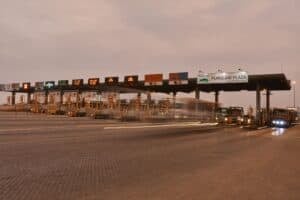No visit to the capital is complete without a day trip to Lake Bled and the majestic Postonja Cave.

The fairy-tale setting welcoming you to Ljubljana couldn’t be more inviting: A dream-like castle keeping vigil on a hill above; a tranquil river running beneath magnificent bridges; medieval cobblestone streets and walkways lined with bars, cafés, restaurants and markets; friendly residents, old and young, cycling effortlessly in every direction.
No wonder year-in and out, this charming Slovenian capital with only 300,000 inhabitants lures thousands of visitors from all over the world to immerse themselves its rich history, cultural heritage, traditional delicacies and scenic beauty.
Judging by the great number of tourists early in the current summer season, it is evident that former East bloc countries like Slovenia (together with Croatia the former Yugoslavia) and Slovakia (along with the Czech Republic the former Czechoslovakia) have made significant strides in the democratic sense of the word, with tourism’s contribution increasingly filling the state coffers.
Nestling on the banks of the willow-strewn Ljubljanica River, Ljubljana is truly a beautiful, lush gem. The fact that it walked away with the laurels as the European Green Capital in 2016 is hardly surprising.
Over the years, Mayor Zoran Jankovic has played a leading role in making the city centre almost entirely pedestrian. Urban spaces have been spruced up with public art and two glorious green “lungs” – Tivoli Park and Rožnik Hill – where residents and visitors alike can enjoy a range of recreational activities and cultural sights.
Besides a distinctly festive atmosphere and mood, much of the city’s charm lies in the large student population that gives it a buzz and spirit few other cities can match. This reaches a crescendo at the brilliant and uniquely Ljubljana creation, Open Kitchen, every Friday from mid-March to October, when the whole town descends en masse on the marketplace in the old town to savour dishes from all over the country, and beyond.
Besides its world-class cuisine, Slovenia is also well-known for producing quality wines. The city’s outdoor wine tasting in November has become so popular in recent years that the organisers had to add an additional June event when Slovene producers set up stalls across the old town and offer generously poured glasses of their wines for around €1 (R17) each, my pocket city guide points out.
A night cap on our hotel balcony with a near full moon and the castle a spectacular backdrop provided a perfect end to our first day in the city, whetting the appetite for the funicular ride to and tour of this famous landmark, followed by a city walkabout the next morning.
Standing on a hill above the city for about 900 years, the castle is the city’s main attraction. Unlike many other castles in Europe, this one truly belongs to the people of the city. This is thanks to Ivan Hribaar, a former mayor of the city, who on May 16, 1905 purchased the castle in the name of the city from the state.
It houses a museum exhibition on Slovenian history, a puppet museum and a number of historical rooms such as the Chapel of St George, the Prison, as well as a video presentation room called Virtual Castle.
There is also a café, a nightclub, and two restaurants that serve as venues for exhibitions, cultural events, dance evenings and open-air film screenings in the summer. Another popular event is the Castle Day festivities, with events for the whole family.
Besides all-year round festivities, Ljubljana oozes culture. Three exceptional works by Verdi feature in this year’s city festival: Aida, Requiem and La Traviata.
Also well worth a visit are cultural hubs like the grand National Gallery, the Museum of Modern Art and the City Museum where you can see remnants of the city’s Roman past. Just walking around in Ljubljana is a cultural experience in itself, as musicians often perform in the streets.
The old part of the town is linked to the commercial section by a number of bridges, with the Dragon Bridge (Zmajski Most) the most well-known. Spanning the Ljubljanica at the heart of the city, this bridge derives its name from the mighty dragon statues at each corner, which, with another 16 smaller dragon statues, uphold its reputation as one of the most photographed structures in the city.
The Dragon Bridge is the subject of many legends, among them that when a virgin crosses, the dragons wag their tails. A favourite good luck charm, the dragon is also a city symbol representing strength, power and grandeur.
No visit to Ljubljana is complete without a day trip to Bled and the majestic Postonja Cave. Often described as the “Image of Paradise”, the Alpine pearl of Lake Bled is an enchanting emerald-green lake with the famous church in the middle (one of the most photographed sights in the world) and the imposing castle on top of a rocky cliff.
Likewise, no words can do justice to the magnificence of the Postonja Cave and the nearby mysterious Predjana Castle. Suffice to say that the 24m-long cave does more than justice to its status as a World Heritage Site.
Incidentally, Slovenia has an impressive number of caves – over 11,000, but only 20 are open to the public.
For more news your way, download The Citizen’s app for iOS and Android.










